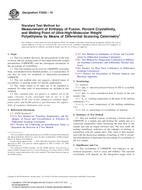We need your consent to use the individual data so that you can see information about your interests, among other things. Click "OK" to give your consent.
ASTM F2625-10
Standard Test Method for Measurement of Enthalpy of Fusion, Percent Crystallinity, and Melting Point of Ultra-High-Molecular Weight Polyethylene by Means of Differential Scanning Calorimetry
STANDARD published on 1.12.2010
The information about the standard:
Designation standards: ASTM F2625-10
Note: WITHDRAWN
Publication date standards: 1.12.2010
SKU: NS-54270
The number of pages: 4
Approximate weight : 12 g (0.03 lbs)
Country: American technical standard
Category: Technical standards ASTM
The category - similar standards:
Annotation of standard text ASTM F2625-10 :
Keywords:
crystallinity, differential scanning calorimetry, heat of fusion, melting temperature, thermal analysis, UHMWPE, ICS Number Code 07.030 (Physics. Chemistry), 17.200.10 (Heat. Calorimetry)
Additional information
| Significance and Use | ||||||||||||
|
The crystallinity of UHMWPE will influence its mechanical properties, such as creep and stiffness. The reported crystallinity will depend on the integration range used to determine the heat of fusion, and the theoretical heat of fusion of 100 % crystalline polyethylene used to calculate the percent crystallinity in an unknown specimen. Differential scanning calorimetry is an effective means of accurately measuring both heat of fusion and melting temperature. This test method is useful for both process control and research. |
||||||||||||
| 1. Scope | ||||||||||||
|
1.1 This test method discusses the measurement of the heat of fusion and the melting point of ultra-high-molecular weight polyethylene (UHMWPE), and the subsequent calculation of the percentage of crystallinity. 1.2 This test method can be used for UHMWPE in powder form, consolidated form, finished product, or a used product. It can also be used for irradiated or chemically-crosslinked UHMWPE. 1.3 This test method does not suggest a desired range of crystallinity or melting points for specific applications. 1.4 The values stated in SI units are to be regarded as the standard. The values given in parentheses are for information only. 1.5 This standard does not purport to address all of the safety concerns, if any, associated with its use. It is the responsibility of the user of this standard to establish appropriate safety and health practices and determine the applicability of regulatory limitations prior to use. |
||||||||||||
| 2. Referenced Documents | ||||||||||||
|
Similar standards:
Historical
1.9.2013
Historical
15.3.2014
Historical
1.5.2010
Historical
1.5.2010
Historical
1.6.2010
Historical
1.8.2011
We recommend:
Technical standards updating
Do you want to make sure you use only the valid technical standards?
We can offer you a solution which will provide you a monthly overview concerning the updating of standards which you use.
Would you like to know more? Look at this page.



 ASTM E1461-13
ASTM E1461-13 ASTM E1782-14
ASTM E1782-14 ASTM E1862-97(2010)..
ASTM E1862-97(2010).. ASTM E1897-97(2010)..
ASTM E1897-97(2010).. ASTM E1933-99a(2010)..
ASTM E1933-99a(2010).. ASTM E1952-11
ASTM E1952-11
 Cookies
Cookies
